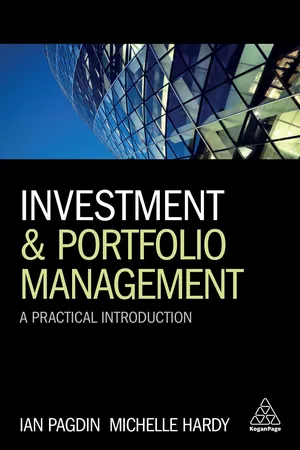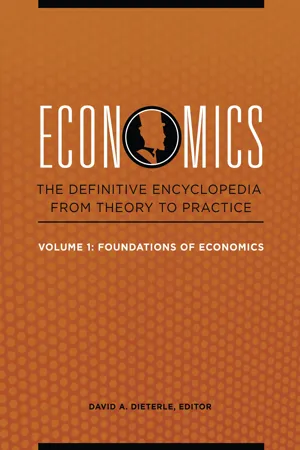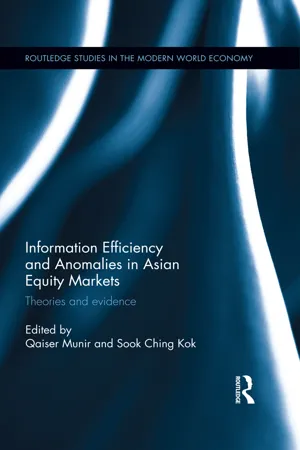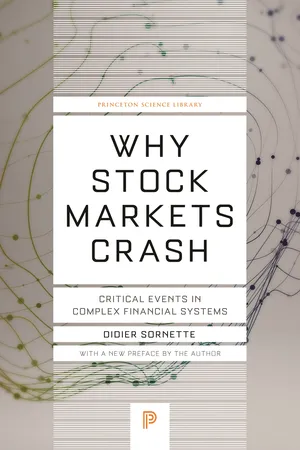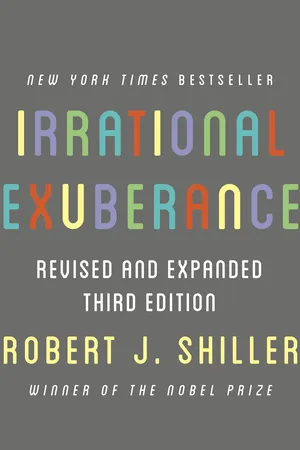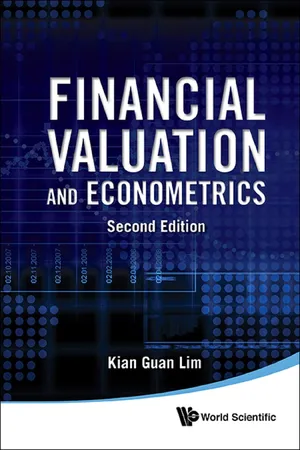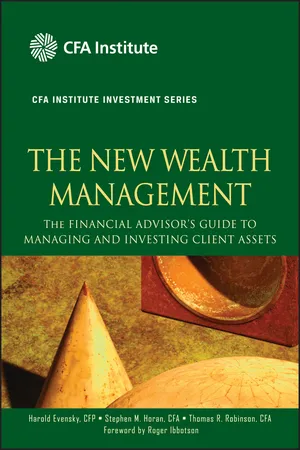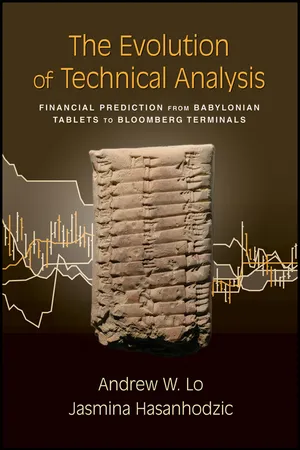Economics
Random Walk Theory
The Random Walk Theory posits that stock prices and other financial assets move randomly, making it impossible to predict their future movements based on past prices. According to this theory, the price changes in financial markets are unpredictable and follow a random pattern, making it difficult for investors to consistently outperform the market through stock picking or market timing strategies.
Written by Perlego with AI-assistance
Related key terms
Related key terms
1 of 4
Related key terms
1 of 3
12 Key excerpts on "Random Walk Theory"
- eBook - ePub
Investment and Portfolio Management
A Practical Introduction
- Ian Pagdin, Michelle Hardy(Authors)
- 2017(Publication Date)
- Kogan Page(Publisher)
In this chapter we will not seek to justify, test, or affirm the various theories and models but simply to discuss them and explain their uses and limitations within the modern investment management arena. The reader who finds that their appetite for further knowledge has been awakened will no doubt wish to research the various topics in greater detail and this is certainly encouraged by the authors. Only by researching the various theories and models widely and in more depth can the reader make an informed decision regarding their personal opinions and preferred investment strategies.Random Walk Theory
This theory traces its roots back to the early analysis of stock market price changes over periods of time. Maurice Kendall found to his surprise that he could not identify a predictable pattern in share price changes;4 indeed, the prices appeared to behave in a random manner as they were as likely to rise as they were to fall on any given day. This was of concern to financial economists and analysts of that time, because it seemed to imply irrationality in the markets and cast doubts upon the skills of those involved in dealing in the markets. Closer study, however, indicated that the random nature of share price movements actually pointed to the market being efficient and this gave rise to the Random Walk Theory and the efficient market hypothesis, with its lingering effects upon investment policy and methods. Much of the work initially carried out centred on large quantities of empirical analysis but little in the way of theoretical research.Passage contains an image
KeywordThe Random Walk Theory - eBook - ePub
Economics
The Definitive Encyclopedia from Theory to Practice [4 volumes]
- David A. Dieterle(Author)
- 2017(Publication Date)
- Greenwood(Publisher)
R RANDOM WALKThe concept of random walk can be applied to professional fields and academia alike. At its base, it is a mathematic theory that centers on the randomness and unpredictability of events. A random walk is frequently associated with phenomena such as stock prices and other probabilistic models typified by Markov chains or stochastic processes. Stochastic processes are fundamentally a probabilistic set of events used to describe the randomness and unpredictability of a certain outcome based on the core principle of choice. Random walk implies that there is not a set outcome of an event but rather an infinite number of outcomes.This theory is specifically applied where multiple complex predictors exist. The random walk as a core principle suggests that picking a specific outcome is not possible and therefore that predictors are not necessarily effective. Similarly, the scientific application, typified by a Markov chain, explains that the changing state of a particle (from solid to liquid, etc.) is not dependent on prior states but rather solely on the current state and the randomness of events to influence change into a future state. With regards to the random walk, this suggests that historical events do not necessarily have an effect on the future of that item.Most famously, random walk principles have historically been the center of debate within the field of economics and investing in the stock market. Investment experts are challenged by the random walk principle as it undermines their profession. Investment professionals rely on predictors and gathered historical results and analysis to predict short- and long-term changes in specific stocks. Their expertise and experience should allow for greater returns on investments. However, many academics argue that the stock market follows random walk principles. These principles indicate that the prices of stocks are in reality random and unpredictable. Furthermore, historical indicators are not relevant to changes in stock prices. - eBook - ePub
- Andrew W. Lo, A. Craig MacKinlay(Authors)
- 2011(Publication Date)
- Princeton University Press(Publisher)
Part ITHE FIVE CHAPTERS IN THIS FIRST PART focus squarely on whether the Random Walk Hypothesis is a plausible description of recent US stock market prices. At the time we started our investigations—in 1985, just a year after we arrived at the Wharton School—the Random Walk Hypothesis was taken for granted as gospel truth. A number of well-known empirical studies had long since established the fact that markets were “weak-form efficient” in Roberts's (1967) terminology, implying that past prices could not be used to forecast future prices changes (see, for example, Cowles and Jones (1973), Kendall (1953), Osborne (1959, 1962), Roberts (1959, 1967), Larson (1960), Cowles (1960), Working (1960), Alexander (1961, 1964), Granger and Morgenstern (1963), Mandelbrot (1963), Fama (1965), and Fama and Blume (1966)). And although some of these studies did find evidence against the random walk, e.g., Cowles and Jones (1973), they were largely dismissed as statistical anomalies or not economically meaningful after accounting for transactions costs, e.g., Cowles (1960). For example, after conducting an extensive empirical analysis of the “runs' of US stock returns from 1956 to 1962, Fama (1965) concludes that, “…there is no evidence of important dependence from either an investment or a statistical point of view.”It was in this milieu that we decided to revisit the Random Walk Hypothesis. Previous studies had been unable to reject the random walk, hence we surmised that perhaps a more sensitive statistical test was needed, one capable of detecting small but significant departures from pure randomness. In the jargon of statistical inference, we hoped to develop a more “powerful” test, a test that has a higher probability of rejecting the Random Walk Hypothesis if it is indeed false. Motivated partly by an insight of Merton's (1980), that variances can be estimated more accurately than means when data is sampled at finer intervals, we proposed a test of the random walk based on a comparison of variances at different sampling intervals. And by casting the comparison as a Hausman (1978) specification test, we were able to obtain an asymptotic sampling theory for the variance ratio statistic almost immediately, which we later generalized and extended in many ways. These results and their empirical implementation are described in Chapter 2 - eBook - ePub
Information Efficiency and Anomalies in Asian Equity Markets
Theories and evidence
- Qaiser Munir, Sook Ching Kok(Authors)
- 2016(Publication Date)
- Routledge(Publisher)
The random walk hypothesis on the small and medium capitalized segment of the Indian stock marketVinod Mishra and Russell Smyth1.0 Introduction
A market in which futures prices cannot be predicted using past historical price data is weak-form market efficient (Fama, 1970). A market that is weak-form efficient is said to be characterized by a random walk. A random walk ‘is a term loosely used in the finance literature to characterize a price series where all subsequent price changes represent random departures from previous prices’ (Malkiel, 2003: 60). The implication is that if a market is characterized by a random walk, an uninformed investor purchasing a diversified portfolio will obtain, on average, a rate of return as good as that realized by an expert (assuming a comparable level of risk).Since the early studies of Samuelson (1965) and Fama (1970), a sizeable literature has evolved that tests the efficient market hypothesis (EMH) in financial markets. Hiremath and Kumari (2014: 1) suggest, ‘There is no theory that has attracted volumes of research like the EMH.’ Lim and Brooks (2011) survey much of this literature. Beginning with Chaudhuri and Wu (2003, 2004) there is an increasing number of studies that have tested the EMH in emerging stock markets (see, e.g. Gough and Malik, 2005; Maghyereh, 2005; Phengpis, 2006; Lean and Smyth, 2007; Cooray and Wickremasinghe, 2008; Hasanov and Omay, 2008; Munir, Kok, Furouka and Mansur, 2012; Wang, Zhang and Zhang, 2015).One of the most common approaches to test the EMH is to test for a unit root in stock prices. If stock prices contain a unit root, this implies that any shock to stock prices will be permanent and, hence, it is not possible to predict future prices based on movements in past prices. Such a finding would be consistent with stock prices being weak-form efficient or exhibiting a random walk. The alternative hypothesis is that stock prices are mean reverting, implying that prices will revert to their natural mean over time, thus making it possible to forecast future price movements using past data. - eBook - ePub
- P. J. O'Rourke(Author)
- 2018(Publication Date)
- Atlantic Monthly Press(Publisher)
SECTION VIRandom Walk
Phil Donahue: “What about the poor?” Ayn Rand: “Don’t be one of them.”—Attributed to an interview with Rand onDonahue circa 1979 (not recorded in thetranscript and probably apocryphal but,as we journalists say, “too good to check”)Passage contains an image
Introduction
A random walk goes nowhere in particular. Thus the theme of this section, which doesn’t have one.But “Random Walk” is also an important statistical concept. The phrase was coined by mathematician Karl Pearson (1857–1936), father of the modern discipline of statistics. And cursed be his name by all business majors being frog-marched through required courses in Statistics. (Pearson, the SOB, also invented the Standard Deviation.)All “Random Walk” really means is that you have a formula or algebraical process the outcome of which is completely random. This turns out to be a surprisingly difficult thing to do in mathematics. (Just as it turns out to be a surprisingly easy thing to do in life.) A jollier term for it is “Drunken Walk,” and all business majors who’ve managed to pass Statistics should treat themselves to one.In economics the Random Walk is a key element of the “Efficient Market Theory” or “EMT.” EMT asserts that the price of an asset (the usual example is a publically traded stock) reflects all the information available about the intrinsic value of that asset.Therefore every asset is always “correctly priced” at any given time. And, because new information about the asset will be randomly favorable or unfavorable to the value of the asset, future changes of price will be a Random Walk and therefore impossible to predict.In other words, if you’re trying to figure out whether the stock market will go up or down, you’re fucked. Unless you’re a genius and have an original way—that nobody else knows—of analyzing all the information available about the intrinsic value of an asset. You’re not a genius. You’re fucked.With one exception. Efficient Market Theory fails to allow for the possibility that you are a liar, a thief, and a fraud. You may have presented information about an asset that’s not true. You may be concealing “insider trading” information that you should have publically disclosed. You may be Bernie Madoff. - eBook - ePub
Princeton Science Library
Critical Events in Complex Financial Systems
- Didier Sornette(Author)
- 2017(Publication Date)
- Princeton University Press(Publisher)
25 ]. To account for the apparent erratic motion of stock market prices, he proposed that price trajectories are identical to random walks.THE RANDOM WALKThe concept of a random walk is simple but rich for its many applications, not only in finance but also in physics and the description of natural phenomena. It is arguably one of the most important founding concepts in modern physics as well as in finance, as it underlies the theories of elementary particles, which are the building blocks of our universe, as well as those describing the complex organization of matter around us. In its most simple version, you toss a coin and walk one step up if heads and one step down if tails. Repeating the toss many times, where will you finally end up standing? The answer is multiple: on average, you remain at the same position since the average of one step down and one step up is equivalent to no move. However, it is clear that there are fluctuations around this zero average, which grow with the number of tosses. This is shown in Figure 2.9 , where the trajectory of a synthetic random market price has been simulated by tossing “computer coins” to decide whether to make the price go up or go down. In this simulation, the steps or increments have random signs and have amplitudes distributed according to the so-called Gaussian distribution, the well-known bell curve.To the eye, it is rather difficult to see the difference between the synthetic and typical price trajectories such as those in Figures 1.7 –1.8 , except at the time of the crash leading to jumps or when there is a strong market trend or acceleration as in Figures 2.1 and 2.2 - eBook - ePub
Irrational Exuberance
Revised and Expanded Third Edition
- Robert J. Shiller(Author)
- 2015(Publication Date)
- Princeton University Press(Publisher)
Part FourAttempts to Rationalize Exuberance
Passage contains an image
Eleven
Efficient Markets, Random Walks, and Bubbles
T he theory that financial markets are efficient forms the leading intellectual basis for arguments against the idea that markets are vulnerable to excessive exuberance or bubbles. Extensive academic research has been widely seen as supporting this theory.The efficient markets theory asserts that all financial prices accurately reflect all public information at all times. In other words, financial assets are always priced correctly, given what is publicly known, at all times. Price may appear to be too high or too low at times, but, according to the efficient markets theory, this appearance must be an illusion.Stock prices, by this theory, approximately describe “random walks” through time: the price changes are unpredictable, since they occur only in response to genuinely new information, which by the very fact that it is new is unpredictable. The efficient markets theory and the random walk hypothesis have been subjected to many tests using data on stock markets, in studies published in scholarly journals of finance and economics. Although the theory has been statistically rejected many times in these publications, by some interpretations it may nevertheless be described as approximately true. The literature on the evidence for this theory is well developed and includes work of the highest quality. Therefore, whether or not we ultimately agree with it, we must at least take the efficient markets theory seriously.Basic Arguments That Markets Are Efficient and That Prices Are Random WalksThe idea of efficient markets is so natural that it has probably been with us for centuries. Although the term efficient markets apparently first became widely known through the work of University of Chicago professor Eugene Fama (who was jointly awarded the Nobel Prize in Economic Sciences with me in 2013, despite our different views on some basic issues) in the late 1960s, the theory itself preceded this name by many years.1 It was clearly mentioned in 1889 in a book by George Gibson titled The Stock Markets of London, Paris and New York. Gibson wrote that when “shares become publicly known in an open market, the value which they acquire may be regarded as the judgment of the best intelligence concerning them.”2 - eBook - ePub
- Kian Guan Lim(Author)
- 2015(Publication Date)
- WSPC(Publisher)
Chapter 7
RANDOM WALK APPLICATION: MARKET EFFICIENCY
Key Points of LearningRandom walk, Rational expectation, Informational efficiency, Equilibrium asset pricing model, Benchmark model, Joint test, Market efficiency, Euler condition, Martingale, Markov process, Strong-form market efficiency, Semi-strong form market efficiency, Weak-form market efficiency, Variance ratio, Long-term memoryIn this chapter, we shall study the mathematical construction of a random walk and how this has been a workhorse for developing the concept of market efficiency in the finance literature. While market efficiency (or informational efficiency, to be more precise about the type of market efficiency discussed here) is a benchmark consideration in an economy with rational agents or investors, it is also important to realise that anomalies and deviations from the benchmark such as in behavioural finance are plausible and possible.7.1RANDOM WALK
Suppose a process Pt +1 follows a random walk:where µ is a constant, and et +1 has zero mean and is not correlated with Pt or E(et +1 | Pt ) = 0, and the coefficient of Pt is b = 1. Moreover, et +1 is not correlated with any other economic variables except Pt +1 . The property of et +1 essentially implies that prices at t + 1 are so unpredictable at t, and that very few if at all any investor can claim to beat the market over any reasonable stretch of time. Note that for a random walk, et +1 need not follow any specific probability distribution. It could as well be a normally distributed noise or a discrete Bernoulli random variable.The strongest version of a random process as in Eq. (7.1) is where et +1 is i.i.d. and E(et +1 ) = 0. A second strong version is where et +1 is independently, but not necessarily identically, distributed and E(et +1 ) = 0. In particular, this allows variance of et +1 to change over time conditionally. A third weak version is where et +1 - eBook - ePub
The New Wealth Management
The Financial Advisor's Guide to Managing and Investing Client Assets
- Harold Evensky, Stephen M. Horan, Thomas R. Robinson(Authors)
- 2011(Publication Date)
- Wiley(Publisher)
The wealth manager should neither accept pricing models as gospel nor reject them out of hand. With respect to individual asset selection, it is the role of portfolio managers to determine the influence of pricing models in their philosophy. The wealth manager’s job is to intelligently evaluate the manager’s philosophy.Recognize that one of the key lessons of both CAPM and APT is that taking on unsystematic risk is not rewarded by the market. Unsystematic risk should be avoided by proper diversification. This important insight has sometimes been misunderstood to mean that diversification provides insurance against market downturns. It does not. It reduces idiosyncratic risk, but not market risk.RANDOM WALKRandom walk, along with its close relation, the efficient market, is a phrase that tends to start active managers frothing at the mouth. Most investors believe that these terms describe a market in which stock prices move in a totally random manner. Although some observers have suggested just such a conclusion, the concept does not depend on stock prices being statistically random; it says only that the arrival of new information is, by definition, random, so future price changes are random and the history of prices cannot be used to predict future prices.The early work in this area by Bachelier (1900), Working (1934), and Cowles (1933) was largely ignored. The concept of market randomness was not revisited until the 1950s. Renewed interest in the 1950s started not in finance or economics but with statistician M. Kendall’s “The Analysis of Economic Time Series,” Harry Roberts’s “Stock Market Patterns,” and astrophysicist M. F. M. Osborne’s “Brownian Motion in the Stock Market.”12 These studies suggested that market prices had no memory. Any information in the past sequence was reflected in the current price.In the 1960s, economists picked up the gauntlet. In 1964, Paul Cootner published The Random Character of Stock Prices - eBook - ePub
Full View Integrated Technical Analysis
A Systematic Approach to Active Stock Market Investing
- Xin Xie(Author)
- 2011(Publication Date)
- Wiley(Publisher)
The stock market follows a random walk if its price movement from point t, in probabilistic terms, is independent of its path before time t; or alternatively put, the distribution of its price movement from point t is independent of its path before time t. While the EMH has been treated most times as the same as the Random Walk Theory, strictly speaking they are different. Efficient market is neither necessary nor sufficient for the market to follow a random walk. As Leroy (1973) and Lucas (1978) show, a non-random walk can exist in an efficient market, defined as a market with no rational incentive for deviation from the equilibrium. This is either due to risk aversion or change in an expected shift in asset value outside of the market portfolio. The key difference between the Random Walk Theory and the EMH is that the dependence or correlation between future price movements and the past price history may not be profitably exploited.However, given the already challenging task of rejecting the random walk hypothesis convincingly, and the messy issue of deciding whether the exploitation of forecastable prices is profitable, testing of the random walk hypothesis has been the focus of the statistical studies. Therefore, the relevance of results from these studies to the EMH is left as very much a matter of personal beliefs; and people on both sides of the issue hold their beliefs firmly.EMH has its deep roots in economics and mirrors closely the invisible hand theory of Adam Smith and the zero profit condition for firms in competitive industries postulated in neoclassical economic theory. According to the invisible hand theory, the market price (in the goods market) is the invisible hand that guides the activities of the producers when they seek to maximize their profitability so that consumption demand is met. Without the need for the visible hands of social planners, the producers, for the sake of their own interest, will supply every unsatisfied consumption need whenever it is profitable to do so, resulting in efficient resource allocation in the economy. Efficiency here means that economic activities cannot be rearranged to make some people better off without hurting other people. The efficiency concept used in the EMH is different from that employed in the invisible hand theory. The former does not necessarily mean efficient resources allocation. However, central to both theories, no profitable opportunities are left unexploited; market prices work as a guide for profit maximizing market participants to exhaust all possibilities for profit at equilibrium. - eBook - ePub
- Frank J. Fabozzi(Author)
- 2012(Publication Date)
- Wiley(Publisher)
Asset prices, of course, cannot be negative. In practice, the probability of the price becoming negative can be made quite small as long as the drift and the volatility parameters are selected carefully. However, the possibility of generating negative prices with the arithmetic random walk model is real.Another problem with the assumptions underlying the arithmetic random walk is that the change in the asset price is drawn from the same random probability distribution, independently of the current level of the prices. A more natural model is to assume that the parameters of the random probability distribution for the change in the asset price vary depending on the current price level. For example, a $1 change in a stock price is more likely when the stock price is $100 than when it is $4. Empirical studies confirm that over time, asset prices tend to grow, and so do fluctuations. Only returns appear to remain stationary, that is, to follow the same probability distribution over time. A more realistic model for asset prices may therefore be that returns are an IID sequence. We describe such a model in the next section.GEOMETRIC RANDOM WALKS Consider the following model:where , … , is a sequence of independent normal variables, andrt, the return, is computed asReturns are therefore normally distributed, and the return over each interval of length 1 has mean μ and standard deviation σ. How can we express future prices if returns are determined by the equations above?Suppose we know the price at time t ,This last equation is very similar to the equation for the arithmetic random walk, except that the price from the previous time period appears as a factor in all of the terms.St. The price at time t +1 can be written asThe equation for the geometric random walk makes it clear how paths for the geometric random walk can be generated. As in the case of the arithmetic random walk, all we need is a way of generating the normal random variables . We start with an initial price S 0 , which is known. We also know the values of the drift μ and the volatility σ over one period. To generate the price at the next time period, S 1 , we add μ·S 0 to S 0 , simulate a normal random variable from a standard normal distribution, multiply it by σ and S 0 , and add it to S 0 + μ·S 0 . At the next step (time period 2), we use the price at time period 1 we already generated, S 1 , add to it μ·S 1 , simulate a new random variable from a standard normal distribution, multiply it by σ and S 1 , and add it to S 1 + μ·S 1 . We proceed in the same way until we generate the desired number of steps of the geometric random walk. For example, given a current price S - eBook - ePub
The Evolution of Technical Analysis
Financial Prediction from Babylonian Tablets to Bloomberg Terminals
- Andrew W. Lo, Jasmina Hasanhodzic(Authors)
- 2011(Publication Date)
- Bloomberg Press(Publisher)
The concept of market efficiency has a counter-intuitive and Zen-like contradictory flavor to it: the more efficient the market, the more random the sequence of price changes generated by such a market must be, and the most efficient market of all is one in which price changes are completely random and unpredictable. Unlike the motivation for Brownian motion in the physical and biological sciences—typically a weak statement of general ignorance regarding the dynamics of interactions—the motivation for randomness in financial markets is the direct outcome of many active participants attempting to profit from their information. Unable to curtail their greed, an army of investors aggressively pounces on even the smallest informational advantages at their disposal, and in doing so, they impound their information into market prices and quickly eliminate the profit opportunities that gave rise to their actions. If this occurs instantaneously, which it must in an idealized world of “frictionless” markets and costless trading, then prices must always fully reflect all available information and no profits can be garnered from information-based trading (because such profits have already been captured).With the benefit of hindsight and the theoretical insights of LeRoy (1973) and Lucas (1973), it is now clear that efficient markets and the random walk hypothesis are two distinct ideas, neither one necessary nor sufficient for the other. The reason for this distinction comes from one of the central ideas of modern financial economics: the necessity of some trade-off between risk and expected return. If a security’s expected price change is positive, it may be just the reward needed to attract investors to hold the asset and bear the corresponding risks. Indeed, if an investor is sufficiently risk averse, he might gladly pay to avoid holding a security that has unforecastable returns. In such a world, prices do not need to be perfectly random, even if markets are operating efficiently and rationally.23Cootner and the other early contributors can hardly be faulted for not appreciating the distinction between efficient markets and the random walk. By itself, the notion of market efficiency is not a well-posed and empirically refutable hypothesis. To make it operational, we must specify additional structure, such as investors’ preferences, the information they each possess, their current financial circumstances, and so on. But then a test of market efficiency becomes a test of several auxiliary hypotheses as well, and a rejection of such a joint hypothesis tells us little about which aspect of the joint hypothesis is inconsistent with the data. The hypothesis that investors are fully rational agents that instantaneously and correctly process all available information is clearly unrealistic—rationality is difficult to define, human behavior is often unpredictable, information can be difficult to interpret, technology and institutions change constantly, and there are significant “frictional” costs to gathering and processing information, and to transacting. But how can we take all the complexities of the real world into account? We tackle this issue in the next chapter. Before doing so, however, we take a short detour to review the historical origins of randomness, a concept that is central not only to quantitative finance, but also to the skepticism surrounding technical analysis.
Index pages curate the most relevant extracts from our library of academic textbooks. They’ve been created using an in-house natural language model (NLM), each adding context and meaning to key research topics.
Explore more topic indexes
Explore more topic indexes
1 of 6
Explore more topic indexes
1 of 4
